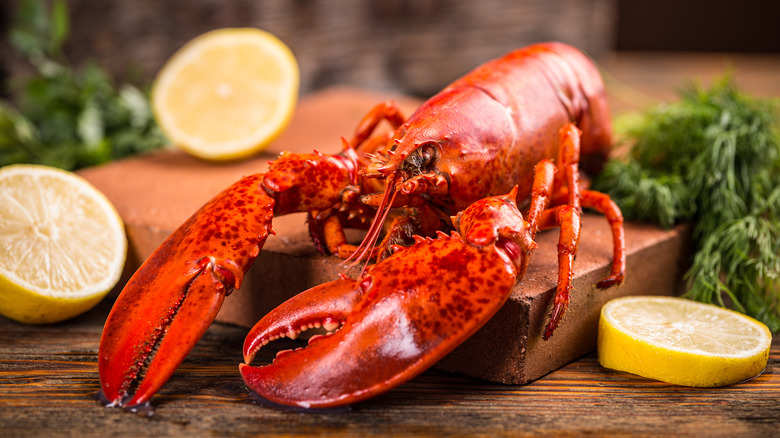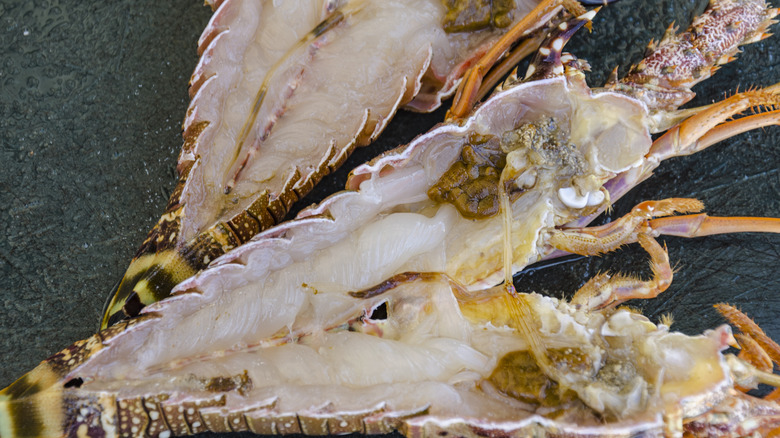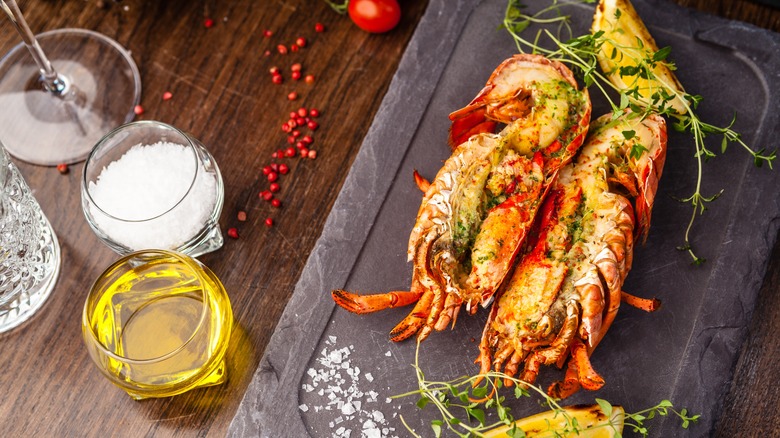What Exactly Is That Green Stuff Inside Lobsters?
Although it was once considered a poor man's food due to the fact that it was so plentiful, lobster is a costly delicacy today, a food often reserved for special occasions due to its high price tag. Those who have eaten lobster have experienced the delight of eating sweet, rich, yet delicate shellfish meat, but not all of them have stumbled upon the tomalley.
Tomalley is a green, pasty substance that is found in the body cavity of a lobster. It looks a little like pesto sauce, wasabi, or guacamole, but no, your lobster hasn't been injected with a condiment. The tomalley is actually the crustacean's hepatopancreas, which functions as both the pancreas and liver. While it's certainly part of the digestive tract, it doesn't contain the creature's waste, like the vein in shrimp that you should remove. The hepatopancreas filters out toxins and pollutants that the lobster has ingested or absorbed from its food and surrounding environment. Despite this, some people consider the tomalley a special indulgence and gladly gobble it up. However, there are some reasons you might be better off leaving the green stuff on your plate.
To eat or not to eat?
You're most likely to come across tomalley if you're eating a whole, intact lobster. When lobster meat has been cooked and separated for you (like in a lobster roll, on salads, or in pastas), it typically doesn't have the tomalley. If you're not expecting it, it may catch you off guard, leading you to scrape it out. But if you see others happily gobbling up this mystery goo, it's because it's both edible and tasty.
Fans of tomalley love its concentrated lobster flavor. It's considered a prize of the ocean, kind of like sea urchin. But eating tomalley isn't completely without risk. The Maine Center for Disease Control & Prevention doesn't recommend consumption of it at all, suggesting that the hepatopancreas may potentially contain a build-up of environmental toxins. If the lobster has been harvested during red tides, when harmful algal blooms are plentiful, it's particularly important to stay away from it.
Still others claim that eating tomalley in moderation isn't a huge risk for healthy individuals, but anyone whose immune system might be vulnerable (children, those who are pregnant) should refrain.
What can you do with the tomalley?
If you prefer not to eat tomalley, it's easy enough to identify when you crack open a lobster. You can simply scrape or wipe away the green stuff and get right to cracking those claws open. But you should also be aware that the tomalley is sometimes added to dishes to give them more flavor, so you should ask the cook if anything you're eating at your seafood joint contains it.
It can be mixed into butter with fresh herbs to make a compound butter; it is sometimes also combined with mayonnaise. Some people will use tomalley as a flavor enhancer and thickener in chowders, sauces, and soups. You should pay particular attention to lobster bisque or lobster stock if you're looking to avoid it, as it's often added to those recipes for extra flavor. Another popular practice is to make a tomalley vinaigrette or mignonette to drizzle over the lobster meat.
If tomalley isn't for you, there are still a number of ways to enhance the flavor of lobster meat, from dunking chunks in clarified lemon butter (simple but timeless) to pairing it with a fantastic glass of Champagne.


